
Wine Culture and Information since 2002 - Volume 22
 Wine Culture and Information since 2002 - Volume 22 |
|
Issue 143, September 2015 |
Contents |
|
|
Wine: a Matter of Points of View |
|
In summer, in July and August, I like to spend my time visiting wineries of old and dear friends as well as to know new ones. Nevertheless, I try to take a break - whenever I can - while admitting I however bring with me something of my job in order not to be in delay when I go back home. Visiting wineries and, in particular, vineyards, is always interesting: not only for the pleasure of sharing opinions with those making wines and spend most of their time in a vineyard, but also to get to know new people and new wines. Seeing old friends and tasting their new wines is interesting and enjoyable. You can share opinions and points of view about wine and its world, while being in company of a good glass always giving new aromas and filled with many wines. With friends and wine makers with whom I am more confident and I know better, it is possible to frankly share opinions, even though in case you do not agree on what they say. In vino veritas. In this period, I also go to restaurants of the places where I am at, frequently choosing them for their wine lists. My goal is not choosing - like to say - “important wine lists”, indeed those having bottles I do not know and never tasted. I in fact like having unknown wines in a neutral place, a context not influenced by the involvement and excitement of being in a vineyard and wineries or in presence of producers. I am absolutely aware a restaurant does not represent the ideal condition for a reliable tasting - too many distractions, too many disturbing factors - however it is always better than nothing. Sometimes I ask restaurateurs or table sommeliers to suggest me something, by explicitly asking them about wines that, in their opinion, better represent their territory and grapes. I am however interested in bottles I never had the chance to taste, last but not the least, for the chance of discovering new wines and, you never know, they could also be good. I do the same with wine shops of the places where I go. I talk to the shopkeepers, I get information about new wineries, their territories and the wines that, in their opinions, deserve particular attention, both in terms of quality and for their viticultural and wine making typicality. Sometimes, I admit this, by doing so I get precious information, most of the times pretty disappointing and distressing advices. This is the case of a shopkeeper I recently met to whom I asked what were - in his opinion - the most representative wines of his territory, by telling him straight away the two wineries I consider to be the best ones of the area. The shopkeeper, while he agreed those two wineries certainly were of remarkable level and their wines of high quality, he confessed - with a firm conviction - there were other wineries even better than those in terms of quality. A quite shocking news: to see your own references to get easily smashed away is something that can happen, however the idea to know there is something even better makes the trauma more acceptable, even pleasurable. Moreover, the shopkeeper said these emerging and amazing wineries are run, in two cases by young and passionate men, willing to keep on the tradition of their grandfathers, whereas, in the other case, there is a well known and successful businessman of the place and who decided to start making wine. Frankly speaking, I am more interested in the wines of the two zealous and willing young men - however deserving admiration - a little less in those of the businessman who, maybe, sees in wine one of the many ways to make a profit. In the last years I frequently tasted wines of certain businessmen who, being in the economic condition of investing money, acquired vineyards and wineries or restaurants. They probably believe money is enough to ensure quality, capable of buying knowledge and skill without any effort but with superficiality and thoughtlessness. The shopkeeper seems to be sure about what he says and - although I have already seen the very same so many times, also with pretty catastrophic endings - I take his advice. You never know, maybe this could also be the right time. The idea of pouring in the glass something better than the two producers I consider to be the best in that area - or however expressing the same quality - is a pretty exciting idea. I therefore take the prodigious bottles, pay them, thank the shopkeeper, while thinking about those glasses promising wonderful emotions. Do you know how it did end? The two wineries I consider to be the best of the area can still have sweet dreams. Very sweet indeed. The two wines made by the zealous young producers, willing to keep the tradition of the territory and of the respective families on - and I sincerely admire them for this - simply were oxidized, dull and flat in their uncertain interpretation. The wine of the businessman who has fallen in love with Bacchus, had fewer faults however nothing which could make you think about a miracle. A wine having no soul, excessively processed in its making, probably result of the wine maker's magic wand. To make this story short, it was not the right time and - I admit it - I still wonder about the personal taste of that shopkeeper and his vision of the territory. In all the three wines I unfortunately perceived what I found more and more in many bottles: approximation and the arrogant superficiality of those who believe making wine is a simple task and that, it is so obvious, it simply takes tradition and some money, when you have it. After all, you just need some grapes, to crush them in order to get the must, keep it in your winery, “do something” and wait. Tradition will certainly be capable of making some Bacchus magic and then wine is ready to be poured and illustrated like the only wonder of the world. Isn't it easy? De gustibus non disputandum est. I know it. And I also know, fortunately, my personal taste and my vision about wine do not represent an absolute reference. However, it is also true that in recent years - this could also be because of the good time wine is having - I see too many bottles result of an evident approximation and superficiality. What it is worse, coarse faults fiercely illustrated as the typical expression of a territory, while giving - nevertheless - the image of a poor quality associated to one's land. Wine has many faces and this is one of the exciting aspects of the beverage of Bacchus. Many territories, many producers, countless combinations and interpretations. And lately, too many faults as well, even embarrassing ones, and - for the sake of decency and honesty - they should be kept, to say the least, hidden in wineries just for the good of one's own land. Antonello Biancalana
|
||||
Contrasts of Montepulciano and CannonauTwo giants of Italian wine making compared in our glasses. The former representing Abruzzo and Marches, the latter Sardinia |
|
This month we are going to compare two typical grapes belonging to quite distant lands, both Italian and however characterized by very different qualities. Montepulciano is the indisputable protagonist of the wine making scene of Abruzzo and Marches. Known and cultivated in other Italian region as well - in particular, Molise, Apulia and Umbria - Montepulciano, one of the greatest Italian red berried grapes, has its highest expression in Abruzzo and Marches. Cannonau is one of the great red berried grapes of Sardinia, among the protagonists of the Italian wine making scene. This grape is also found in other Italian regions - although known with different names - and its origin is being debated since a very long time. Some in fact support the idea Cannonau is a grape of Spanish origins, others believe it is an indigenous variety of Sardinia and from here introduced to Spain and France. Grapes capable of expressing wines with a quite different character, however protagonists of the respective territories. Both can be used in many wine making techniques, giving to the glasses interesting interpretations both in the wine making in inert containers - such as steel or cement tanks - as well as in cask and barrique. The versatility of these two varieties gives excellent results also by the blending with other grapes, both autochthonous and international. One of those, for example, is the well known blending of Cannonau and Bovale grapes, both representing some of the finest red wines of Sardinia. The same can be said for Montepulciano, a grape blending very well to other varieties, including Sangiovese, with which gives, in particular, wines of Conero and Piceno areas in the Marches region. Montepulciano and Cannonau can be appreciated for their respective characters and, also in case they are blended to other grapes, they never pass unnoticed while claiming their identity in the taster's senses. Montepulciano, after having been received a very low interest from producers and consumers, comes to a new life thanks to the willingness of some wineries of Abruzzo and Marches. After having contributed for a long time to the enrichment of wines of other regions, Montepulciano walks its triumphal march upwards to the Olympus of wine right from its land of origin: Abruzzo. It is right from this region the grape begins its glorious march while becoming - today - one of the most interesting and important varieties of Italy. The success of Montepulciano has also been helped by producers of Marches who, in the course of time, favored its use in wines instead of Sangiovese. Conero and Piceno represent the revaluation of Montepulciano in Marches. If it is true that once the blending with Sangiovese was common, in particular in the Piceno area, today it is more common to see wines produced with 100% Montepulciano. This choice, it should be said, has always been favored in Abruzzo: the most famous red wine of this region is in fact generally made with Montepulciano only. The origins of this important variety of Central Italy are quite uncertain, while noticing that Montepulciano has no connection, nor geographical nor viticultural, with the well known town of the same name in province of Siena, Tuscany, and famous in the world for its Vino Nobile. Today most support the idea Montepulciano originates from Torre de' Passeri, a town in province of Pescara, Abruzzo. Of this variety exist few and uncertain historical references and the first written evidences are dated back to the 1700s. It should also be noticed that Montepulciano has been confused for a very long time with Sangiovese, a grape having no connection with it. Fundamental pillar of red wines of Abruzzo and Marches, Montepulciano is also found in Umbria, Molise and Apulia, also used in the composition of denominazione d'origine controllata wines. Montepulciano, as well as Sangiovese, is one of the most important grapes of Central Italy and the progressive revaluation done with time - in particular in Abruzzo and Marches - allowed this grape to be considered today, and with no objection, one of the most significant grapes of the Italian wine scene. Cannonau has been considered for a long time a grape introduced by Spaniards in Sardinia, identified as Garnacha Tinta, a very common grape in Spain. Important archaeological discoveries done in certain areas of the island allowed to completely rewrite the origin and history of Cannonau. The discovery of grape pips dated back to 3200 years ago and belonging to the variety today known as Cannonau, proved that in Sardinia cultivation of vine is a very ancient practice, preceding the arrival of Phoenicians in the island. This important discovery has also allowed the rewriting of the history of viticulture in the Mediterranean area, by confuting the hypothesis supporting vine was introduced by Phoenicians first and then Greeks. The important discovery allowed the new definition of the history of Cannonau and many today support the idea this variety was introduced in Spain under the Aragon rule in the island by importing it right from Sardinia. Cannonau, under different names, is also spread in other parts of the world, in particular Italy and Europe. The famous grape is in fact known in Spain as Garnacha Tinta and Grenache in France, whereas in Italy - depending on the area - it is called Gamay del Trasimeno, Gamay Perugino, Alicante, Granaccia and Tocai Rosso. Cannonau is the most common and cultivated red berried grape in Sardinia, which wines are also ranked as Denominazione d'Origine Controllata in the whole territory of the island. The renowned red of Sardinia has its best expressions in particular in the areas of Jerzu, Capo Ferrato and Nepente di Oliena. Cannonau is suited for different wine making interpretations: not only in red wines - either aged in inert container and cask - but also rose and fortified wines as well.
Our tasting by contrast will examine a Montepulciano d'Abruzzo and a Cannonau di Sardegna, by choosing two bottles belonging to the same vintage and aged in cask. In order not to excessively affect the profiles of the two grapes with unavoidable tertiary aromas contributed by wood and time, wines must not be more than three years old. On this regard, it should be noticed the production disciplinary of Montepulciano d'Abruzzo provides for the use of a minimum 85% of this grape, therefore it is essential our wine to be exclusively made with Montepulciano. Also the disciplinary of Cannonau di Sardegna provides for the use of a small part of other grapes cultivated in the island, therefore it is essential - also in this case - to choose a wine produced with 100% Cannonau. The two wines will be poured in distinct glasses and served at the temperature of 18 °C (65 °F). Let's pour Montepulciano and Cannonau in their respective glasses and begin our tasting by contrast. On this regard, we will use a sheet of paper or a white towel which will allow a better evaluation of color. Let's tilt the glass of Montepulciano, while making sure the whole glass is over the white towel. Let's observe the base of the glass: Montepulciano shows an intense ruby red color, sometimes even deep. Observe now the wine at the edge of the opening: here we will notice an intense ruby red nuance and, sometimes, a purple red hue as well. Let's now pass to the glass of Cannonau and, also in this case, we will tilt it over the towel. The color of the great Sardinian wine shows an intense and brilliant red, a hue which can be observed in the nuances as well. By keeping the glasses tilted and side by side, let's observe the two wines in order to compare differences. Let's now pass to the evaluation of aromas, undoubtedly one of the most exciting and interesting aspects of wine sensorial evaluation. Montepulciano and Cannonau are two grapes capable of making wines - in their respective territories - having remarkable differences in their aromatic profile. Wines produced with Montepulciano, as opposed to Cannonau, are capable of strongly dividing wine lovers because of its particular personality. The famous grape from Abruzzo expresses organoleptic qualities such to be usually considered at the extremities of pleasingness, rarely being in the middle part. Cannonau, also in this case a grape capable of making wines of remarkable personality, certainly is easier and more direct. They however are two great grapes, absolute protagonists of the Italian wine scene, both generous in making wines of remarkable value and personality. Let's begin the evaluation of aromas from the glass of Montepulciano. The opening of this wine let us understand, since the beginning, the great olfactory personality of this variety. It will be in fact perceived a vinous character, sometimes even rustic, something being very typical in Montepulciano and capable of dividing wine lovers: you love it or hate it. Moreover, the opening of Montepulciano gives aromas of plum, black cherry, blackberry and violet. The swirling of the glass will complete the aromatic profile with blueberry and the typical tertiary sensations of wood, such as vanilla, chocolate and a pleasing balsamic touch of menthol. The opening of Cannonau is evidently different: in this wine will be mainly perceived aromas of black cherry, plum, blueberry and violet. Let's now swirl the glass in order to favor the development of other aromas, in which we will perceive raspberry, blackberry and, not being uncommon, aromas recalling aromatic herbs such as juniper and myrtle. Also in this case will be perceived the typical aromas contributed by the aging in wood. Let's now pass to the gustatory evaluation of the two wines, beginning from Montepulciano. The attack will be characterized by an evident sensation of astringency, then followed by the warm and round effect of alcohol, therefore a pleasing crispness. Montepulciano keeps its rustic character to the taste as well, however integrated and well mixed to the other gustatory characteristics of the wine. We will clearly perceive flavors of plum, black cherry and blueberry, sometimes blackberry too. Let's now pass to the glass of Cannonau and take a sip of wine. The attack of the Sardinian wine is characterized in the mouth by a good sensation of astringency, also in this case followed by the generous warm and burning effect of alcohol. As opposed to Montepulciano, in Cannonau will be perceived a weaker crispness, a quality that - in both cases - is strongly affected by the aging in wood and the roundness given by time. The correspondence to the nose is very good: in the mouth we will perceive flavors of black cherry, plum and blueberry. The final phase of the tasting is very interesting in both wines. The finish of Montepulciano is long, leaving in the mouth flavors of plum, black cherry, blueberry and blackberry, as well as its characteristic vinous personality, vaguely rustic. It will also be perceived a pleasing crispness well supported by the roundness given by wood and time. The finish of Cannonau is equally long and in which it is possible to perceive flavors of black cherry, plum, blueberry and, sometimes, raspberry. As opposed to Montepulciano, here it will be perceived a weaker impact of crispness, however both roundness and the warmth of alcohol will support the other gustatory sensations of the wine. In their respective territories, Montepulciano and Cannonau play roles of primary importance, by identifying the respective regions with their wines. In both cases we can certainly talk about stories with a happy ending: grapes once scarcely considered by many, they have become giants of irreplaceable magnificence and today - with no doubt - they are among the greatest grapes of Italy.
|
||||||||||||
Wines of the Month |
|
|
|
Score legend Prices are to be considered as indicative. Prices may vary according to the country or the shop where wines are bought |
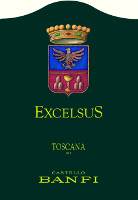
|
|
Excelsus 2010 |
|
| Castello Banfi (Tuscany, Italy) | |
 Merlot (60%), Cabernet Sauvignon (40%) Merlot (60%), Cabernet Sauvignon (40%) | |
| Price: € 38.00 | Score: |
 Intense ruby red and nuances of ruby red, little transparency. Intense ruby red and nuances of ruby red, little transparency. intense, clean, pleasing, refined and elegant, starts with hints of
black currant, black cherry and plum followed by aromas of blueberry,
violet, vanilla, iris, cinnamon, tobacco, chocolate and eucalyptus. intense, clean, pleasing, refined and elegant, starts with hints of
black currant, black cherry and plum followed by aromas of blueberry,
violet, vanilla, iris, cinnamon, tobacco, chocolate and eucalyptus.
 Tannic attack and however balanced by alcohol, full body, intense
flavors, pleasing roundness. Tannic attack and however balanced by alcohol, full body, intense
flavors, pleasing roundness.
 Persistent finish with flavors of black currant, black cherry and plum. Persistent finish with flavors of black currant, black cherry and plum. 20 months in barrique. 20 months in barrique. |
|
 Game, Roasted meat, Stewed and braised meat, Hard cheese Game, Roasted meat, Stewed and braised meat, Hard cheese |
|
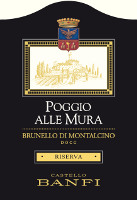
|
|
Brunello di Montalcino Riserva Poggio alle Mura 2009 |
|
| Castello Banfi (Tuscany, Italy) | |
 Sangiovese Sangiovese | |
| Price: € 62.00 | Score: |
 Brilliant ruby red and nuances of garnet red, moderate transparency. Brilliant ruby red and nuances of garnet red, moderate transparency. Intense, clean, pleasing, refined and elegant, starts with hints of
black cherry, plum and dried violet followed by aromas of blueberry,
blackberry, raspberry, vanilla, tobacco, chocolate, cinnamon, leather,
mace, licorice and menthol. Intense, clean, pleasing, refined and elegant, starts with hints of
black cherry, plum and dried violet followed by aromas of blueberry,
blackberry, raspberry, vanilla, tobacco, chocolate, cinnamon, leather,
mace, licorice and menthol.
 Tannic attack and however balanced by alcohol, full body, intense
flavors, agreeable. Tannic attack and however balanced by alcohol, full body, intense
flavors, agreeable.
 Very persistent finish with long flavors of black cherry, plum and
blackberry. Very persistent finish with long flavors of black cherry, plum and
blackberry.
 2 years in barrique and cask, 12 months in bottle. 2 years in barrique and cask, 12 months in bottle. |
|
 Game, Roasted meat, Stewed and braised meat, Hard cheese Game, Roasted meat, Stewed and braised meat, Hard cheese |
|
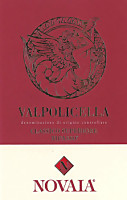
|
|
Valpolicella Classico Superiore Ripasso 2012 |
|
| Novaia (Veneto, Italy) | |
 Corvina (50%), Corvinone (30%), Rondinella (20%) Corvina (50%), Corvinone (30%), Rondinella (20%) | |
| Price: € 20.00 | Score: |
 Brilliant ruby red and nuances of garnet red, moderate transparency. Brilliant ruby red and nuances of garnet red, moderate transparency. Intense, clean, pleasing and refined, starts with hints of black
cherry, blackberry and plum followed by aromas of dried violet, vanilla,
chocolate, tobacco, mace and menthol. Intense, clean, pleasing and refined, starts with hints of black
cherry, blackberry and plum followed by aromas of dried violet, vanilla,
chocolate, tobacco, mace and menthol.
 Properly tannic attack and however balanced by alcohol, good body,
intense flavors, pleasing roundness. Properly tannic attack and however balanced by alcohol, good body,
intense flavors, pleasing roundness.
 Persistent finish with flavors of black cherry, blackberry and plum. Persistent finish with flavors of black cherry, blackberry and plum. 12 months in barrique, 6 months in bottle. 12 months in barrique, 6 months in bottle. |
|
 Broiled meat and barbecue, Stuffed pasta, Stewed meat with mushrooms, Hard cheese Broiled meat and barbecue, Stuffed pasta, Stewed meat with mushrooms, Hard cheese |
|

|
|
Amarone della Valpolicella Classico Riserva Le Balze 2009 |
|
| Novaia (Veneto, Italy) | |
 Corvina, Corvinone, Rondinella, Oseleta Corvina, Corvinone, Rondinella, Oseleta | |
| Price: € 60.00 | Score: |
 Brilliant ruby red and nuances of garnet red, little transparency. Brilliant ruby red and nuances of garnet red, little transparency. Intense, clean, pleasing, refined and elegant, starts with hints of
blackberry, black cherry and dried violet followed by aromas of plum,
blueberry, vanilla, tobacco, chocolate, cinnamon, licorice, mace and
menthol. Intense, clean, pleasing, refined and elegant, starts with hints of
blackberry, black cherry and dried violet followed by aromas of plum,
blueberry, vanilla, tobacco, chocolate, cinnamon, licorice, mace and
menthol.
 Tannic attack and however balanced by alcohol, full body, intense
flavors, pleasing roundness. Tannic attack and however balanced by alcohol, full body, intense
flavors, pleasing roundness.
 Persistent finish with flavors of blackberry, black cherry and plum. Persistent finish with flavors of blackberry, black cherry and plum. 36 months in barrique, 8 months in bottle. 36 months in barrique, 8 months in bottle. |
|
 Game, Roasted meat, Braised and stewed meat, Hard cheese Game, Roasted meat, Braised and stewed meat, Hard cheese |
|
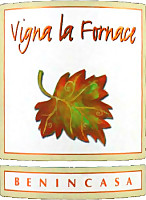
|
|
Vigna La Fornace 2011 |
|
| Benincasa (Umbria, Italy) | |
 Cabernet Sauvignon (50%), Merlot (50%) Cabernet Sauvignon (50%), Merlot (50%) | |
| Price: € 14.00 | Score: |
 Deep ruby red and nuances of garnet red, little transparency. Deep ruby red and nuances of garnet red, little transparency. Intense, clean, pleasing and refined, starts with hints of prunes,
black cherry jam and black currant jam followed by aromas of dried violet,
vanilla, tobacco, mace, chocolate, licorice, leather and eucalyptus. Intense, clean, pleasing and refined, starts with hints of prunes,
black cherry jam and black currant jam followed by aromas of dried violet,
vanilla, tobacco, mace, chocolate, licorice, leather and eucalyptus.
 Properly tannic attack and however balanced by alcohol, good body,
intense flavors, pleasing roundness. Properly tannic attack and however balanced by alcohol, good body,
intense flavors, pleasing roundness.
 Persistent finish with flavors of prune, black cherry jam and black
currant jam. Persistent finish with flavors of prune, black cherry jam and black
currant jam.
 18 months in barrique. 18 months in barrique. |
|
 Roasted meat, Broiled meat and barbecue, Stewed meat with mushrooms, Hard cheese Roasted meat, Broiled meat and barbecue, Stewed meat with mushrooms, Hard cheese |
|
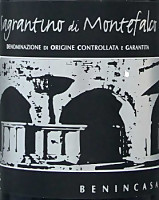
|
|
Montefalco Sagrantino 2009 |
|
| Benincasa (Umbria, Italy) | |
 Sagrantino Sagrantino | |
| Price: € 22.00 | Score: |
 Brilliant ruby red and nuances of garnet red, little transparency. Brilliant ruby red and nuances of garnet red, little transparency. Intense, clean, pleasing and refined, starts with hints of blackberry,
prune and dried violet followed by aromas of black cherry, blueberry,
vanilla, tobacco, chocolate and menthol. Intense, clean, pleasing and refined, starts with hints of blackberry,
prune and dried violet followed by aromas of black cherry, blueberry,
vanilla, tobacco, chocolate and menthol.
 Tannic attack and however balanced by alcohol, full body, intense
flavors, pleasing roundness. Tannic attack and however balanced by alcohol, full body, intense
flavors, pleasing roundness.
 Persistent finish with flavors of blackberry, prune and black cherry. Persistent finish with flavors of blackberry, prune and black cherry. 18 months in barrique. 18 months in barrique. |
|
 Game, Roasted meat, Stewed and braised meat, Hard cheese Game, Roasted meat, Stewed and braised meat, Hard cheese |
|
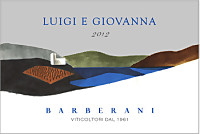
|
|
Orvieto Classico Superiore Luigi e Giovanna 2012 |
|
| Barberani (Umbria, Italy) | |
 Grechetto (90%), Procanico (10%) Grechetto (90%), Procanico (10%) | |
| Price: € 33.00 | Score: |
 Brilliant straw yellow and nuances of straw yellow, very transparent. Brilliant straw yellow and nuances of straw yellow, very transparent. Intense, clean, pleasing and refined, starts with hints of apple, plum
and hazelnut followed by aromas of medlar, pear, peach, hawthorn, citrus
fruits, broom, honey, mineral and hints of vanilla. Intense, clean, pleasing and refined, starts with hints of apple, plum
and hazelnut followed by aromas of medlar, pear, peach, hawthorn, citrus
fruits, broom, honey, mineral and hints of vanilla.
 Crisp attack and however balanced by alcohol, good body, intense
flavors, pleasing roundness. Crisp attack and however balanced by alcohol, good body, intense
flavors, pleasing roundness.
 Persistent finish with flavors of apple, pear and hazelnut. Persistent finish with flavors of apple, pear and hazelnut. 12 months in cask, 18 months in bottle. 12 months in cask, 18 months in bottle. |
|
 Stuffed pasta, Roasted white meat, Roasted fish, Mushroom soups Stuffed pasta, Roasted white meat, Roasted fish, Mushroom soups |
|
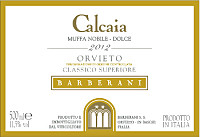
|
|
Orvieto Classico Superiore Calcaia 2012 |
|
| Barberani (Umbria, Italy) | |
 Grechetto (80%), Procanico (20%) Grechetto (80%), Procanico (20%) | |
| Price: € 43.00 | Score: |
 Brilliant amber yellow and nuances of amber yellow, transparent. Brilliant amber yellow and nuances of amber yellow, transparent. Intense, clean, pleasing, refined and elegant, starts with hints of
dried apricot, dried fig and honey followed by aromas of quince jam, dried
fig, candied fruit, date, peach jam, lychee, almond, musk, saffron and nail
polish. Intense, clean, pleasing, refined and elegant, starts with hints of
dried apricot, dried fig and honey followed by aromas of quince jam, dried
fig, candied fruit, date, peach jam, lychee, almond, musk, saffron and nail
polish.
 Sweet and round attack, however balanced by alcohol, good body, intense
flavors, pleasing crispness. Sweet and round attack, however balanced by alcohol, good body, intense
flavors, pleasing crispness.
 Very persistent finish with long flavors of dried apricot, raisin and
date. Very persistent finish with long flavors of dried apricot, raisin and
date.
 12 months in steel tanks. 12 months in steel tanks. |
|
 Hard cheese, Dried fruit tarts Hard cheese, Dried fruit tarts |
|
News |
|
In this section are published news and information about events concerning the world of wine and food. Whoever is interested in publishing this kind of information can send us a mail to our address.
|
AquavitaeReview of Grappa, Distillates and Brandy |
|
|
| Distillates are rated according to DiWineTaste's evaluation method. Please see score legend in the "Wines of the Month" section. |
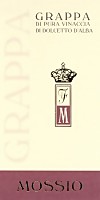
|
|
Grappa di Dolcetto |
|
| Mossio (Piedmont, Italy) | |
| (Distiller: Distilleria Montanaro) | |
 Pomace of Dolcetto Pomace of Dolcetto | |
| Price: € 23.90 - 70cl | Score: |
 Limpid and crystalline with a very pale straw yellow color. Limpid and crystalline with a very pale straw yellow color. Intense, clean, pleasing and refined with aromas of cherry, raspberry.
plum, violet, hazelnut, licorice and almond with almost imperceptible
alcohol pungency. Intense, clean, pleasing and refined with aromas of cherry, raspberry.
plum, violet, hazelnut, licorice and almond with almost imperceptible
alcohol pungency.
 Intense flavors with perceptible alcohol pungency which tends to
rapidly dissolve, pleasing roundness, balanced sweetness. Intense flavors with perceptible alcohol pungency which tends to
rapidly dissolve, pleasing roundness, balanced sweetness.
 Persistent finish with flavors of cherry, raspberry and plum. Persistent finish with flavors of cherry, raspberry and plum. Distilled with a steam operated batch alembic still. Distilled with a steam operated batch alembic still. |
|
Wine Parade |
|
|
| The best 15 wines according to DiWineTaste's readers. To express your best three wines send us an E-mail or fill in the form available at our WEB site. |
| Rank | Wine, Producer | |
|---|---|---|
| 1 |
| Verdicchio dei Castelli di Jesi Classico Superiore Podium 2010, Garofoli |
| 2 |
| Brunello di Montalcino Montosoli 2009, Altesino |
| 3 |
| Offida Rosso Il Grifone 2008, Tenuta Cocci Grifoni |
| 4 |
| Adarmando 2011, Tabarrini |
| 5 |
| Brunello di Montalcino Vigneto Manachiara 2007, Tenute Silvio Nardi |
| 6 |
| Montiano 2011, Falesco |
| 7 |
| Trento Extra Brut Riserva Lunelli 2006, Ferrari |
| 8 |
| I Sodi di San Niccolò 2008, Castellare di Castellina |
| 9 |
| Camartina 2011, Querciabella |
| 10 |
| Torgiano Rosso Riserva Rubesco Vigna Monticchio 2007, Lungarotti |
| 11 |
| Trento Extra Brut Perlé Nero 2007, Ferrari |
| 12 |
| Sagrantino di Montefalco Collepiano 2007, Arnaldo Caprai |
| 13 |
| Pelago 2009, Umani Ronchi |
| 14 |
| Avvoltore 2011, Moris Farms |
| 15 |
| Villa Gresti 2006, Tenuta San Leonardo |
| |||||||
Privacy Policy | |||||||


| Copyright © 2002-2024 Antonello Biancalana, DiWineTaste - All rights reserved |
| All rights reserved under international copyright conventions. No part of this publication and of this WEB site may be
reproduced or utilized in any form or by any means, electronic or mechanical, without permission in writing from DiWineTaste. |